What a way to finish the science component of the cruise! We did our last station this morning, station 140. We did not have any major equipment failure int he whole cruise. Here is the map for the cruise with all the stations we did. I can not believe the cruise is almost over. After so many hours of hard work by all on the ship.
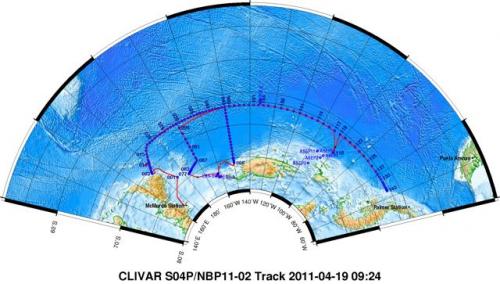
Today's excitement about the end of the science sampling was eclipsed by an amazing event, one that oceanographers will talk about for years and years, since it is nothing we have heard of happening before.
At the end of last week, a couple of scientists at Woods Hole Oceanographic Institution (WHOI), Dr. Bob Bearsley and Dr. Dick Limburner, hit the oceanographic jackpot. Ten years ago they deployed six moorings relatively close to the Antarctic Peninsula. Jim Ryder, who came on this cruise to deploy a mooring and retrieve others, remembers when he helped deploy those six moorings at the end of March of 2001.
Jim went back on a different cruise a year later to retrieve all the instruments, but they were only able to find five of the six moorings. The release did not work on the last one, and they were not able to find it by trolling a line with hooks on it. Luckily for Bob and Dick, they had placed an Argo float on the upper most buoy. Argo floats have a GPSA Global Positioning System (GPS) is a satellite-based navigation system used to track the location or position of objects on the Earth’s surface. and a transmitter that beams its location to a satellite.
Bob and Dick must have been very surprised last Thursday when they received notice that their mooring was beaming its location from the surface after nine years. They contacted a British research station on the Antarctic Peninsula, Rothera Station, which is relatively close to the location where the mooring was. They did not know about our cruise.
People at Rothera figured out we were in the area and contacted us about the ghost mooring that was floating around. It turned out that we were relatively close and with enough time to swing by and pick it up. After the first half of the cruise full of stormy weather, we have enjoyed a week of placid waters, which allowed us to finish the science with some spare time.
We still needed to find the mooring that was drifting. We knew where it had been four hours before our arrival to the area. We did not have an updated location because the satellite passes around these waters every now and then as it orbits earth. We had quite a few people scrutinizing the horizon from the bridge. The visibility was poor due to light fog, but the waters were very calm, which helped locate the mooring. It actually did not take long for one of us to spot the buoys.
This is an amazing story! Jim got to recover a mooring that had eluded him nine years ago. Bob and Dick were lucky to have their mooring pop up to the surface at the time in which the mooring expert that installed it ten years ago was on board an oceanographic cruise nearby and with time to spare. The recovery was flawless. Jim tried to extract the data form the instruments, but the batteries, as expected, are all gone. The instruments will be send back to WHOI for data recovery. I will be at WHOI over the summer, so I plan to follow up with what happened to the instruments!
The mooring is a time capsule itself. The two current meters are 'old style' . These are called Averaging Current Meters (ACM) because they do an average of the currents over a specified period of time. The have a rotor that spins according to the current speed. The image below shows the rotor blades on white at one end of a current meter, and the other end of the current meter in yellow.
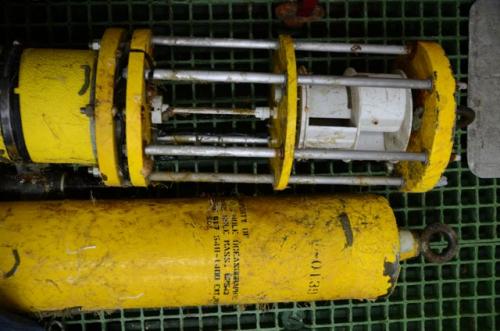
Another big difference with the mooring we recovered a month ago is the large amount of organisms attached to the instruments, floats and even the cable. There are anemones, tunicates (sea-squirts), worms, and sponges. Here is picture of an anemone on the release.
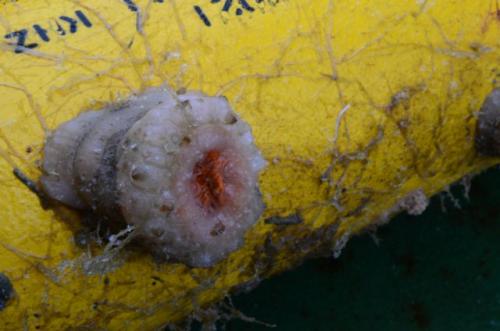
And here is one of the tunicates on the bottom half of the largest float. They are much larger than the ones I remember seeing before.
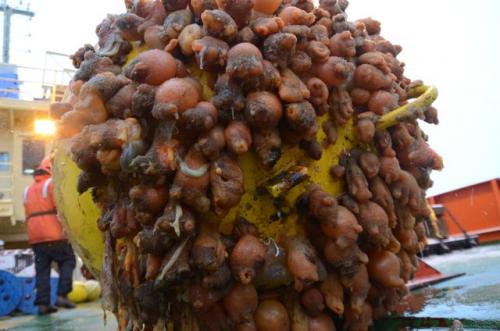
The mooring also had an old style ADCP (old as in ten years old). The instrument and the cage are also covered with organisms.
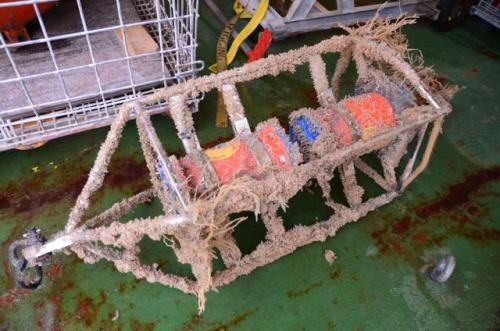
How did the mooring released nine years later? It seems that the release ended up working, but we do not know why now.
Now that science has been completed and we begin sailing towards Chile, the night watch is transitioning to living during the day. Some have been awake since 11:00 pm last night, and plan to go to bed until 10:00 or 11:00 tonight. Others did take a short nap. People are beginning to pack their equipment, and I have more journal entries planned than days left on the cruise…
El fondeo fantasma
¡Que manera de terminar la parte científica del crucero! Terminamos la última estación, la número 140, de madrugada. No tuvimos fallos de equipo en todo el crucero. Aquí un mapa con la posición de todas las estaciones. Me cuesta creer que la expedición llega a su fin. Han sido muchas horas de trabajo arduo por parte de todos abordo.

La gran emoción de haber terminado los muestreos fue eclipsada por un evento impresionante, uno de esos sobre el quede los oceanólogos hablarán por muchos años, ya que no sabemos de un hecho así.
Al final de la semana pasada, un par de científicos en Wood Hole Oceanographic Institution (WHOI), el Dr. Bob Bearsley y el Dr. Dick Limburner, se sacaron la lotería oceanográfica. Hace diez años instalaron seis fondeos relativamente cerca de las costas de la Península Antártica. Jim Ryder, quien vino com o el experto de fondeos en este crucero, recuerda haber ayudado a instalarlos a fines de marzo del 2001.
Jim regresó un año después abordo de otra embarcación para recuperar los instrumentos, pero solo recuperaron cinco de los seis fondeos. El liberador no funcionó en el último, y los esfuerzos por pescarlo con varios ganchos amarrados a un cable fue infructuoso. Por suerte para Bob y Dick, ellos colocaron un flotador Argo en la última boya. Los flotadores Argo tienen un posicionador satelital (GPS) y un transmisor que le envía señales a un satélite cuando se encuentra en la superficie del agua.
Menuda sorpresa se habrán llevado Bob y Dick el jueves pasado cuando recibieron la noticia de que el fondeo estaba emitiendo su posición en la superficie del mar. Contactaron de inmediato una base británica en la Península Antártica, Rothera Station, la cual está cerca del sitio en el que emergieron las boyas. Ellos no sabían sobre nuestro crucero.
La gente de Rothera se dieron cuenta que nosotros merodeábamos la zona y nos informaron sobre el crucero fantasma. Resultó que estábamos relativamente cerca del sitio en cuestión, y que teníamos tiempo de sobra. Después de la primer mitad del crucero con grandes tormentas, hemos disfrutado una semana de aguas plácidas, lo que nos ha permitido ganar tiempo.
Todavía teníamos que encontrar las boyas a la deriva. Sabíamos dónde habían estado cuatro horas antes de que llegamos a la zona. No teníamos una posición más actualizada porque el satélite no había pasado por la zona. Había varios observadores en el puente de manos buscando los flotadores. La visibilidad era pobre debido a una ligera niebla, pero las aguas tranquilas nos ayudaron a encontrar el tesoro.
Esta es una historia maravillosa. Jim recuperó un fondeo que le eludió hace nueve años. Bob y Dick tuvieron la suerte de que el fondeo emergiera al tiempo en el que el experto en fondeos que lo instaló hace diez años estuviera en un crucero oceanográfico en la zona y con tiempo de sobra.que un crucero oceanográfico estaba en la zona. El trabajo de recuperación fue impecable. Jim intentó extraer los datos de los instrumentos, pero, como se esperaba, tienen la batería muerta. Los instrumentos serán regresados a WHOI. Da la casualidad que yo estaré en WHOI durante el verano, por lo que pienso averiguar la suerte de los datos.
El fondeo es una cápsula de tiempo. Los dos corentímetros son 'antiguos'. Se les conoce como Corretnímetros de Promedio (ACM por sus siglas en inglés) porque obtienen el promedio de las corrientes en un tiempo predeterminado. Tienen unas aspas conectadas a un rotor que gira de acuerdo a la rapidez de las corrientes. La siguiente imagen muestra las aspas en blanco y el extremo opuesto del otro corentímetro.

Otra gran diferencia entre este fondeo y el que recuperamos hace un mes es la gran cantidad de organismos que vivían sobre los instrumentos, flotadores e incluso el cable. Encontramos anémonas, tunicados, gusanos y esponjas. Aquí una foto de una anémona en el liberador.

Y aquí una de los tunicados que estaban debajo de la boya más grande. Son más grandes de los que recuerdo haber visto antes.

El fondeo también tenía un ADCP antiguo (ver diario del 4 de abril para una explicación del ADCP). El instrumento y su armazón también estaban cubiertos de organismos.

¿Cómo se liberó el fondeo después de nueve años? Al parecer el liberador acabó por funcionar, pero no sabemos porque hasta ahora.
Ahora que hemos terminado la parte científica y comenzamos a navegar hacia CHile, el turno nocturno empieza la transición a la vida diurna. Algunos llevan despiertos desde las 11:00 pm de anoche, y planean seguir asía hasta las 10:00 u 11:00 pm. Otros han tomado una pequeña siesta. La gente empieza a empacar su equipo, y yo tengo más diarios planeados de los días que quedan en el crucero...


Comments